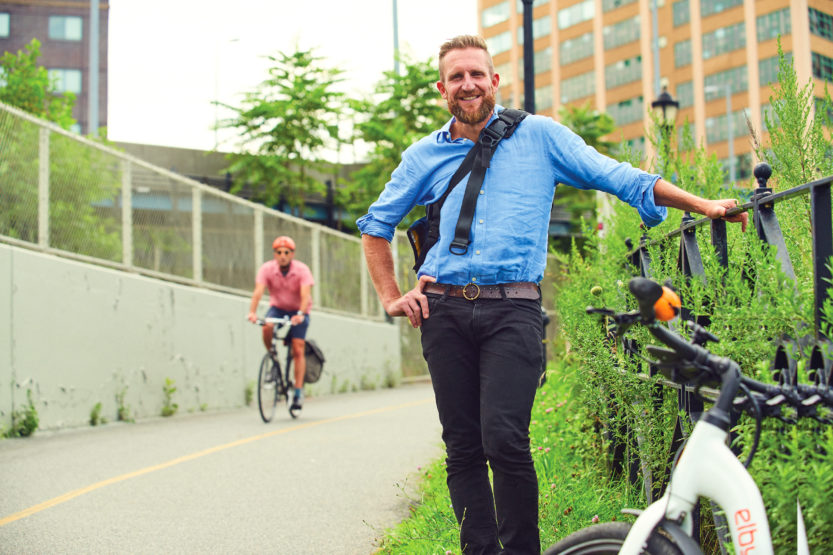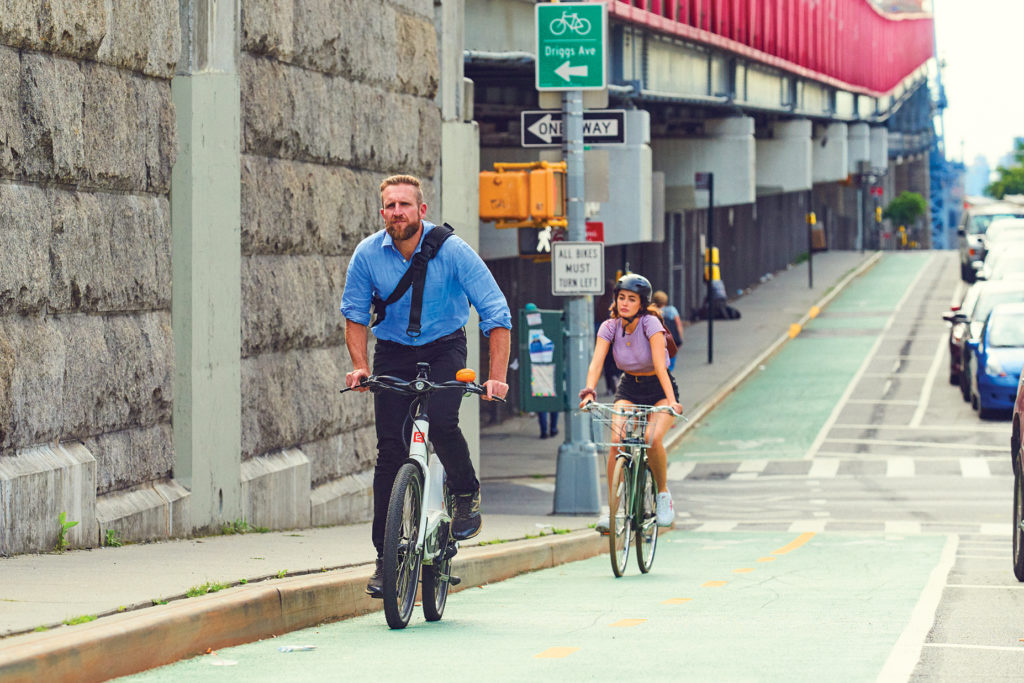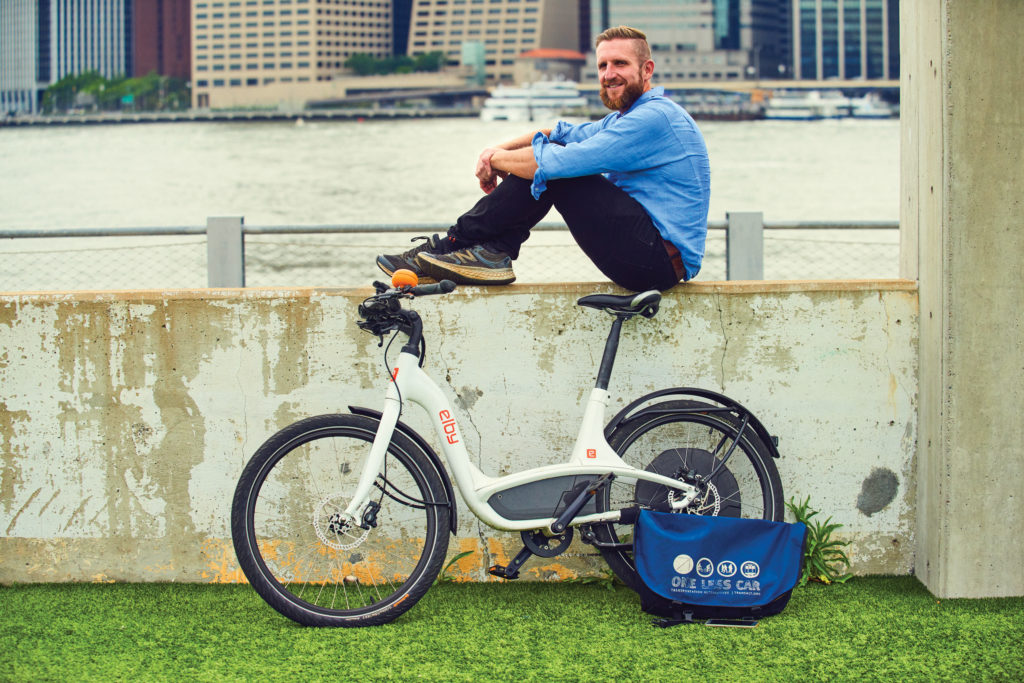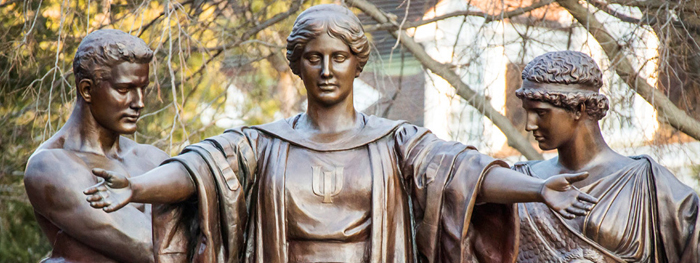Lane Crusader
 An advocate for bicycling and pedestrian rights, Paul Steely White is a veteran of the bike-rights movement Critical Mass and the “dark days” of New York City cycling. (Image by James Farrell)
An advocate for bicycling and pedestrian rights, Paul Steely White is a veteran of the bike-rights movement Critical Mass and the “dark days” of New York City cycling. (Image by James Farrell) In the dark days of bicycling in New York City—which is to say, in the last few decades of the 20th century—you either had to be mad or a bicycle messenger to enjoy it. If you owned a bike and kept it on the street, you covered it in black tape to make it look ugly to thieves and carried a chain heavy enough to hobble an elephant. And you never, ever played chicken with a taxi.
It was this asphalt jungle, with its gridlocked intersections and honking horns and shouted expletives, that drew bicycle advocate Paul Steely White, ’95 LAS, in 1997. At the time, he was working in Washington, D.C., for the Institute for Transportation and Development Policy, an organization that provides public-transport and planning expertise to local authorities across the globe. In his job, White traveled to Africa and other continents to encourage developing nations not to make the same urban-planning mistakes (i.e., building only for cars) that the U.S. had made for decades.
But back in New York City, he was fighting the same battles, such as riding with Critical Mass—a bicyclists’ movement started in San Francisco in 1992, in which a group of bikers rode together to bring city traffic to a halt. White recalls getting arrested after one such event on Earth Day in 1998, and emerging from a precinct house to cheers from fellow cyclists waiting outside.
“Those early rides were galvanizing for many of us coming up in the movement,” White, now 47, recalls. “You had a feeling of riding with hundreds of people, safely and with camaraderie. It was such a marked contrast to the usual experience of riding on city streets, fraught with danger and feeling very isolated and vulnerable.”
Since then, biking has become mainstream. “The movement has certainly grown up,” White says. “But it retains its healthy sense of irreverence. Maybe it has more of an energy and vitality of the street that really can’t be bridled. We’re trying to get more of a critical mass of public opinion, getting bodies in the street,” he adds. “There’s a tipping point. When we get a high enough volume of bicyclists, we achieve a mainstreaming.”
New York City has come a long way since then, and so has White. For the past 15 years, he has served as executive director of Transportation Alternatives, one of the nation’s leading advocates for bicycling and pedestrian rights. Over the past 15 years, TransAlt has been instrumental in the push to bring bicycle lanes and bike-share programs to New York City, and in promoting the rights of cyclists and walkers.
“It’s tricky to play a public role in New York City,” says Steve Hindy, co-founder of Brooklyn Brewery and a TransAlt board member. “The media is aggressive and always looking for blood. Paul has been able to clearly state the case for transportation alternatives and navigate a lot of difficult and controversial issues in a very adept way. He’s avoided a lot of unnecessary conflicts.”

Thanks to the work of urban-cycling advocates like White, New York City is becoming bike-friendly, with nearly 400 miles of dedicated bike lanes and a shared-cycle program that makes 12,000 bikes available for more than 22 million rides a year. (Image by James Farrell)
Ticket to freedom
White has been a bicycle lover for most of his life. When he was 6 years old, growing up in rural Illinois, his parents went through a messy divorce. White moved in with his dad, who bought him a Schwinn Stingray, the classic boy’s bike, with a banana seat, high-rise handlebars and a stick shift on the top tube. “It was my ticket to freedom,” he recalls. “I achieved escape velocity from all of the yuckiness of that whole divorce ordeal. It was my happy place.”
In high school, while friends rode around in cars, White preferred pedaling. One year, he spent a summer detasseling corn and bought a $600 road bike. He brought the bike with him for his undergraduate years at Illinois, riding it home on breaks and taking it on longer bike tours with panniers to carry his gear.
White moved—by bike, of course—to Missoula for graduate school at the University of Montana and took a job with what was then known as Bikecentennial. Now known as the Adventure Cycling Association, the group is one of the nation’s largest advocates for noncompetitive cycling. From there, he moved to New York City in 1997.
Those first few years were not welcoming to bikes, but the 2001 mayoral transition from Rudolph Giuliani to Michael Bloomberg brought a change in attitude. Instead of enforcing jaywalking violations, as Giuliani famously did during his tenure, Bloomberg’s administration began to add bicycle lanes to city streets and took other steps to make the city more welcoming to non-motorized transport (as has Bloomberg’s successor, current mayor Bill de Blasio).
Today, the city has added nearly 400 miles of bike lanes to its roads, and its Citi Bike program has 12,000 bikes that are used more than 22 million times a year, according to Janette Sadik-Khan, former commissioner of the New York City Department of Transportation.
“Paul’s advocacy was key to our success,” recalls Sadik-Khan, who is now a principal at the philanthropic consultancy group Bloomberg Associates. “Having members come to community board meetings to show support for bike lanes and be available to the media helped underscore the message about bike lanes making our streets better for everyone,” she says. “It’s not to say we agreed all the time. We had lots of lively discussions along the way.”
At a time when the city’s transportation commissioners were being mauled by conservative papers such as the New York Post about the bike lanes—“You have to grow a thick skin if you’re going to make change,” says Sadik-Khan—White never relented.
“Paul was always the guy who had to be out there pushing for more,” recalls Hindy, who became a bicycle advocate after his 27-year-old son was killed while cycling in the city. “Trans-Alt laid the groundwork—they’re the foot soldiers for the whole movement.”
Marketing to the “bike-curious”
Today, the organization is based in a second-story office near Wall Street. It looks more like the home of a tech startup, with its open floor plan and stand-up desks. There’s a small stable of e-bikes in the center of the room, a living-room’s worth of couches at one end, and at nine on a Friday morning, almost no one around.
The two dozen employees wander in over the next hour, including White. At 10, the staff gathers for a bagel breakfast as White holds his bi-monthly meeting. There, he congratulates staffers for being on-point during recent press interviews and for helping to promote new issues.
One new concern is trying to hold private hauler-owned garbage trucks accountable for safer driving: Seven pedestrians were killed by such trucks in 2017, according to ProPublica. Another is to plan for the closing of the busy L subway line. The L train, which carries 250,000 commuters between Brooklyn and Manhattan every day, will close for 18 months so the Canarsie Tunnel, damaged by the floodwaters of superstorm Sandy in 2012, can be repaired. White sees this as a great way to promote bicycle commuting to folks he refers to as “bike-curious.”
It’s a busy day for White. In the afternoon, he has a meeting with Dan Brownell, comissioner and chair of the New York City Business Integrity Commission, to discuss private garbage trucks. Later, White will do interviews with Bloomberg News and The Wall Street Journal on several bike-related topics.
But first, he has to get to Brooklyn to meet his wife, Zoe Ryder White, and his twin toddlers, for a pediatric appointment (he also has a 9-year-old daughter, who has just been allowed to bike on city streets). Of course, White goes to his appointment by bike.
This relatively simple journey shows that biking in New York City still has its issues. First, he can’t get a Citi Bike—the nearby station is empty. He disappears around a corner and reappears with a TransAlt delivery bike. This eight-foot-long behemoth, with a giant basket behind the front wheel, acts as a sort of rolling billboard for TransAlt. There’s a sticker with the word “Accident” crossed out and the word “Crash” written above it—part of a campaign to encourage greater police enforcement of traffic rules when bicyclists are hit by cars and trucks. Stuck between the spokes of the front tire is a laminated card: “We ride together now.”
Helmetless, layered in several light jackets and a wool hat, White races up the Brooklyn Bridge bike path. A couple of college-age tourists wave a full-size American flag in front of White, jeering as if they are matadors at a bullfight. White rides by, then stops in a fury. “You hit me in the face!” he yells, amazed.
A minute later, a woman shooting a picture of the iconic bridge tower steps into his lane, and he swerves into a railing, tumbling over and injuring his leg. Finally, safely on the Brooklyn side, he mutters, “Well, that was harrowing.”
But there is no time for White to dwell on the hazards of bicycle-pedestrian interactions. He is running late. He stomps on the pedals and heads off into the traffic of Brooklyn, a single urban cyclist fighting for space in a motorized world.


